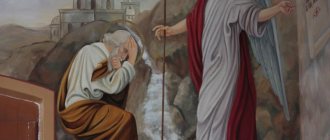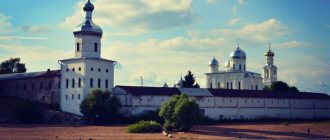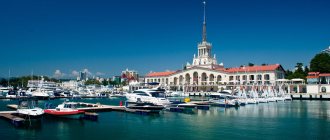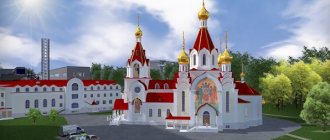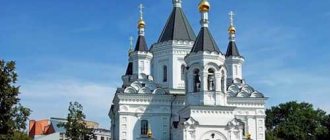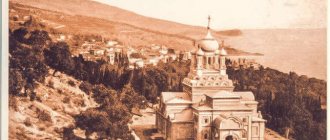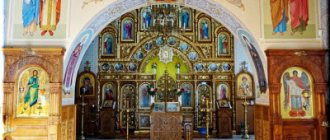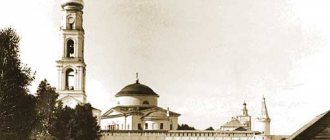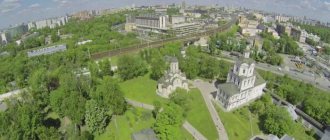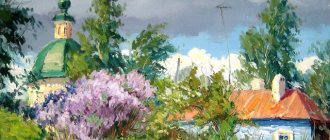| Moscow Miracle Monastery |
Moscow monastery in honor of the Miracle of Archangel Michael in Khoneh
(destroyed)
- Address: Russia, Moscow
- On the map: Yandex.Map, Google map
One of the oldest monasteries in Moscow, Chudov, was founded by Saint Alexy of Moscow in 1365 in memory of the miraculous healing of Taidula, mother of the Khan of the Golden Horde, Janibek, from blindness.
Through the prayers of Saint Alexy, Taidula received her sight and, in gratitude, gave Alexy the court of the khan's governors, located in the Moscow Kremlin. On the site of this courtyard, Metropolitan Alexy founded a monastery. It began with a stone church in honor of the Miracle of the Archangel Michael in Khoneh, founded in September 1365 - one of the earliest stone churches in Moscow [1]. After his death, Saint Alexy was buried here, in the Miracle Church. Probably from the time of its foundation the abbots of the monastery had the rank of archimandrites. Soon, in 1382, the monastery was destroyed by the troops of Tokhtamysh. Over the years, the Chudov Monastery played a prominent role in Russian history, and is famous for its prisoners and necropolis. Thus, the deposed Metropolitan of Moscow Uniate Isidore was imprisoned here in 1441; the outstanding educator and fighter against heresies, Metropolitan of Novgorod Saint Gennady in 1504; Elder Vassian Kosoy (Patrikeev) in 1515. In 1610, the deposed Tsar Vasily IV Shuisky was forcibly tonsured a monk at the Chudov Monastery. Two years later, in the cell of the Chudov Monastery, the holy martyr Patriarch Ermogen died of hunger, thrown into prison by the Poles.
The Chudov Monastery housed the tombs of many historical figures. Metropolitans of Moscow Athanasius and St. were buried here. Simon; the last Kazan king Edigei, Simeon in holy baptism (+ 1565); famous church figure of the 17th century Epiphany Slavinetsky. Some sources claim that St. Theodosius, Metropolitan, was buried in the Chudov Monastery. Moskovsky, however, E.E. Golubinsky, referring to the inventory of 1641, speaks of a cover that was placed in the Serapion tent (Trinity-Sergius Lavra) on the tomb of St. Theodosius, Metropolitan. Moskovsky [2]. Representatives of many princely and boyar families were buried in the monastery: the matchmaker of Tsar Alexei Mikhailovich, boyar I. I. Morozov, princes Trubetskoy, Khovansky, Obolensky, Kurakin, Shcherbatov.
For centuries, the baptism of royal children was invariably performed in the Alekseevsky Church of the monastery. The children of Ivan the Terrible were baptized here, the future Tsar Alexei Mikhailovich was baptized here in 1629, Peter I in 1672, and Emperor Alexander II in 1818.
According to one version, the monk of the Chudov Monastery was the impostor Grigory Otrepiev.
The Chudov Monastery reached its heyday at the beginning of the 17th century, when it was called the “Great Lavra”. Under Patriarch Filaret, a Greek-Latin school (“patriarchal school”) was opened here. In 1666, a Council of Patriarchs and Bishops took place in the Chudov Monastery, at which Moscow Patriarch Nikon was deposed. During these years, the construction of new churches and other buildings was carried out in the monastery. In 1686, the relics of St. Alexis were transferred to a church specially built in the monastery, consecrated in his honor. The sacristy of the monastery housed the rich deposits of tsars, grand dukes and boyars, and the monastery library, which contained many ancient rare books, was one of the most significant book depositories in Russia.
In 1744, by decree of Empress Elizabeth Petrovna, the department of the Moscow Bishop was established in the monastery and since then the monastery began to be called a cathedral. In 1771, during the plague riot, the monastery was plundered by Muscovites.
During the Patriotic War of 1812, when Moscow was captured by the French, the Chudov Monastery was badly damaged. Napoleon's headquarters were located here. At that time, the relics of St. Alexis were desecrated and thrown into cesspools, and Marshal Davout’s bedroom was built in the altar of the cathedral. Subsequently, the relics were rediscovered and returned to their original location. After the fire, Chudov was restored in 1814. Then the famous Moscow architect M.D. Bykovsky worked on the beauty of the monastery, who installed a bronze iconostasis with beautiful silver Royal Doors in the renovated cathedral church.
| Miracles Monastery. Photo. 1883 |
During the era of reforms of Emperor Alexander II, a highly approved committee began to work at the Chudov Monastery to collect and store national donations for the construction of a thanksgiving church in the name of St.
Alexander Nevsky - in honor of the liberation of Russian peasants from slavery. Oddly enough, this great temple, next in status after the Cathedral of Christ the Savior, was never built in Moscow: only in 1904 was its foundation site on Miusskaya Square solemnly consecrated and its construction timed to coincide with the 50th anniversary of the abolition of serfdom. It was only in 1913 that construction work began, interrupted by World War I. And then the almost erected building, which was never consecrated, was dismantled by the Bolsheviks for bricks and a house of pioneers was built there. In November 1917, the monastery was shelled.
Then, for some time, monks remained in the Kremlin monastery - in close proximity to the Bolshevik government, which moved to Moscow from Petrograd in 1918. The new Kremlin residents did not like this neighborhood, and already in 1919 the monastery was closed. Some kind of cooperative “Communist” opened in its premises, and in the basement of the Alekseevskaya Church - a “reading hut”. Then the valuables were taken from the monastery and transferred to the Kremlin Lechsanupr, where the best doctors observed the supreme patients.
The Miracle Monastery was destroyed in 1930. The cathedral church was blown up a little earlier - on the night of December 17, 1929, under the pretext that a place was needed to house a military school where Kremlin cadets would be trained. Employees of the Central State Restoration Workshops, sent to the Moscow Kremlin, came to work on December 17 and “ found the temple blown up and a pile of construction waste.”
" Two 16th-century frescoes left on the scaffolding, carefully removed by restorers from the walls the day before, were also destroyed. The monastery was destroyed to free up privileged territory for the construction of the government building of the Presidium of the Supreme Council, designed by I. Rerberg. The relics of St. Alexy were transferred to the Archangel Cathedral, and in 1947 Patriarch Alexy I asked to be moved to the Yelokhovsky Cathedral, where they rest to this day. The icons from the monastery were transferred to the Armory Chamber and the Tretyakov Gallery.
Temples, architecture
Miracle Cathedral
The cathedral in honor of the Miracle of Michael the Archangel was built in 1501 on the site of a dismantled ancient temple.
Alekseevsky Temple
The stone church in the name of St. Alexis of Moscow, erected in 1483, burned and was rebuilt several times. The walls of the church were decorated with trophies of Russian troops captured during the Russian-Persian War of 1826-1828.
The relics of St. Metropolitan Alexy rested in the Alekseevskaya Church. Next to the saint’s tomb his vestments were kept, according to legend, donated by Khansha Taidula. In 1905, Grand Duke Sergei Alexandrovich, killed by the terrorist Kalyaev, was buried in the basement of the Alekseevskaya Church. The remains of the Grand Duke were discovered during excavation work in 1985, and ten years later they were transferred to the Romanov family tomb in the Novospassky Monastery.
St. Andrew's Church
The small church was dedicated to the Apostle Andrew the First-Called.
Annunciation Church
The temple in honor of the Annunciation of the Blessed Virgin Mary was adjacent to the Alekseevskaya Church. It was built in 1501 and rebuilt in 1826. The locally revered icon of St. Nicholas the Wonderworker was kept in the Church of the Annunciation.
Miracles Monastery, origins
Estimated reading time: less than a minute.
In the summer of 2014, Russian President V.V. Putin announced his intention to restore two monasteries in the Kremlin that were destroyed by the Bolsheviks. Other government officials and Moscow Mayor Sobyanin confirmed the seriousness of this plan. But what exactly will be built on the site of the lost monasteries? It’s time to remember what the origin of the destinies of these two monasteries was, what kind of people stood at their foundation, what temples were barbarously destroyed.
I have already had occasion to turn to the fate and antiquities of the Ascension Star-Devichy Monastery
Now a word about Chudov.
The famous Miracle Monastery is the brainchild of Saint Alexy, Metropolitan of Moscow and All Rus'.
The monastery was born in the middle of the 14th century. Most historians date its appearance to 1365. Formally, then Grand Duke Dmitry Ivanovich ruled. But because of his youth, Moscow Russia was actually ruled by the boyar government led by Metropolitan Alexy.
As a politician, Metropolitan Alexy enjoyed enormous influence in Moscow. He was allowed to conclude treaties on peace and war and even begin fortress construction. The saint consistently acted in favor of Moscow. Sometimes he even excommunicated political opponents of the Grand Duke from the Church. He tried with all his might to extend the dominance of the Moscow principality in Rus' - after all, it was there that the metropolitan see was located! Any wars, riots, devastation in Muscovite Rus' could disrupt the calm and serene existence of the Russian Church. But Alexy also had other reasons: there is nothing good in strife from the point of view of Christian morality. When Moscow became a powerful center of unity, Rus' gained hope of getting rid of the endless inter-princely “discord” and “dislike” in the future. By supporting Moscow, Saint Alexy maintained peace.
The Miracle Monastery is a large Russian shrine. His fate is connected with the biographies of several great figures of our Church.
In 1611 - early 1612, that is, at the very height of the Time of Troubles, Patriarch Hermogenes became a prisoner of the Chudovsky dungeon. The officers of the Polish garrison and the pro-Polish administration decided that Hermogenes was inconvenient, because he blessed the creation of the Zemsky militia, and did not yet recognize Prince Vladislav as the Russian Tsar (he did not convert to Orthodoxy). Hermogenes underwent several stages of imprisonment. The stay in the basements of the Chudov Monastery was the most difficult. In fact, the old patriarch ended up in a stone bag: he spent several months there, after which he died. But he did not give in to the Poles and Russian traitors; he stood unshakable in his faith. Hermogenes was canonized under Nicholas II. Shortly before 1917, the dungeon-prison became a place of pilgrimage: people walked and walked to the relics of the new saint.
The last two Moscow patriarchs before the abolition of the patriarchate under Peter I, Joachim and Adrian, left the abbots of the Chudov Monastery.
Miracles Monastery. Photo 1883
In addition, the monastery had a huge book depository. It was a kind of intellectual center of the Russian Church. From there the most educated editors went to the Moscow Printing Yard. Major theologians and scribes worked there. From there came, for example, the great scribe Euthymius, the head of the intellectual “party” of Old Moscow conservatives in the second half of the 17th century.
Chudov was built over a long period of time: some buildings were demolished, others grew in their place.
By the beginning of the 20th century, the oldest building, namely the one that appeared in the 14th century, had not survived. But on the territory of the monastery there was the Cathedral of St. Michael the Archangel of the early 16th century with the “fresh” Hermogenes Church, built underground several years before the revolution; Metropolitan Alexy Cathedral and St. Andrew's Church of the 17th century; Church of St. Joasaph, Bishop of Belgorod, which appeared in 1911. In other words, a whole ensemble of church buildings from different times, ancient and new. In the second half of the 18th century, the monastery had a beautiful porch with turrets in the Gothic style - its author was the famous Moscow architect Matvey Kazakov.
Chudov grew and developed along with the Kremlin itself, and was an organic part of the Kremlin. The Kremlin at the beginning of the 20th century was a rather motley sight. There were very ancient buildings from the 14th – 15th centuries, temples and chambers from the time of the Muscovite kingdom, buildings from the imperial era... The Kremlin was a collection of architecture dating back to different times and different styles. In this sense, it was like the whole of Moscow, easily connecting on one street the ancient pre-Petrine chambers, the mansion of Catherine’s nobleman and the apartment building of the Art Nouveau era. In an architectural sense, Chudov is as colorful as the Kremlin as a whole, like the whole of Moscow.
We can say with confidence: we still face endless debates about how to restore the Kremlin monasteries.
There will certainly be dreamers who will call for the revival of buildings from the time of Dmitry Donskoy and his widow. Let no one know what they looked like, let it be a flight of fancy, but the prospects are breathtaking!
But realists will object to them: it would be better to historically restore buildings that were preserved by 1917. For modern experts, recreating what the Chudov and Stardevichy Monasteries looked like under Nicholas II is not such a difficult task. There are more than enough materials for this. There are photographs and drawings of what they looked like at the end of the 18th, 19th and early 20th centuries. There are restoration projects related to the oldest buildings of the Chudov Monastery. This approach will more firmly tie the restoration of the monasteries to the spiritual soil of Moscow antiquity.
S. M. Shukhvostov. Interior view of the Alekseevskaya Church of the Chudov Monastery. 1849
The second point of view, realistic, is the only correct one. The two monasteries are not only “architectural complexes,” but also shrines. Their historical destinies are higher and more important than any creative games of modern architecture. One must have respect for the saints who lived in the Kremlin monasteries, for the monks who inhabited the cells there. There’s no point in building a beautiful… fiction on their bones.
Someday monastic communities will appear in Chudov and Starodevichy, and someday church singing will begin to sound there. After all, they are not being restored for the sake of a museum future, that would be ridiculous! And the monks will need a lot of respect for their great predecessors in this place.
This is what we should proceed from.
Abbots
- Elisha the Tap Dancer (mentioned no later than 1378)
- Sschmch. Pitirim (? - after 1441)
- Theodosius (Byvaltsev) (mentioned 1453 - June 23, 1454)
- St. Gennady (Gonzov) (1472 - December 12, 1484)
- Jonah (Sobina) (mentioned 1518 - no later than 1544)
- Leonidas (1568/1570 - December 4, 1571)
- Varlaam (Belkovsky) (mentioned 1589 - February 20, 1592)
- Gennady (1592 - February 16, 1595)
- Paphnutius (? - 1602/1605)
- Paul (1659 - August 21, 1664)
- Joachim (Savelov) (1664 - December 22, 1672)
- Paul (September 15, 1674 - ca. 1678)
- Adrian (mentioned 1678 - March 21, 1686)
- Evfimy (Rylkov) (March 28, 1686 - August 12, 1688)
- Joasaph (Lazarevich) (1688 - 1691)
- Arseny (Kostyurin) (January 12, 1692 - July 2, 1704)
- Theophylact (Lopatinsky) (March 9, 1722 - February 24, 1723)
- Jacob
- Aaron (1734 - December 23, 1735)
- Cyprian (Skripitsyn) (May 3, 1736 - December 31, 1737)
- Varlaam (Skamnitsky) (March 8, 1739 - February 27, 1743)
- St. Hilarion (Grigorovich) (1743 - December 17, 1744)
- Moscow metropolitans (1744 - mentioned 1917)
- …
- Joseph (mentioned 1758)
- Paisius (mentioned 1761)
- Paisius II (1765 - 1766)
- Misail (mentioned 1768)
- Barnabas (1774 - 1777) [3]
- …
- Theophylact II (1815 - 1819) [4]
- Aaron II (mentioned 1822 - 1825) [5]
- Ioannikiy (Kholuysky) (March 12, 1834 - December 3, 1845) [6]
- Veniamin (Petukhov) (August 16, 1859 - 1884) [7]
- Tobia (Tsymbal) (June 9, 1893 - early 1903)
- Arseny (Zhadanovsky) (March 26, 1904 - June 8, 1914?) [8]
- Sschmch. Seraphim (Zvezdinsky) (mentioned August 14, 1917)
An ordinary miracle
Already from the name of the monastery it is clear that its foundation is associated with a miracle. If you believe the chronicle story “About Alexei Metropolitan,” it happened in 1357. It so happened that Taidula, the mother of the Horde khan Janibek, fell ill with her eyes and became blind. The inconsolable son turned to Metropolitan Alexy of Kyiv and All Rus' with a request for help. The head of the Russian church arrived in the capital of the Golden Horde, Sarai, prayed at the patient’s bedside, and a miracle happened - the woman received her sight.
Photo: commons.wikimedia.org
Miracle Monastery, 1883
Image of salvation: what secrets will the restoration of the Assumption Cathedral reveal?
The main temple of the Moscow Kremlin suffered from the liberalism of Alexander II
In gratitude for the rescue, Janibek and Taidula presented the Metropolitan with land in the Kremlin, where the Horde Embassy Court was located, on which the monastery was founded. They named it in honor of the Miracle of the Archangel Michael in Khoneh - in Phrygia, the archangel with a blow of his rod diverted a mountain stream, which the pagans directed to destroy the Christian temple, and this miracle became a symbol of the protective protection of Orthodoxy from infidels. The plot has nothing to do with the events in the Barn, but their metaphysical proximity is obvious.
Perhaps everything was not entirely as it was, or even completely different from what is told in the life of Alexy, especially since it was created approximately a hundred years after the events described, when the Metropolitan was canonized. Relatively young, only the appointed primate is unlikely to have enjoyed such great fame as a healer, in any case, nothing is known about this. Versions have been put forward that Taidula was a Russian Polonyanka by origin, which at least somehow explains what happened. There is an assumption that it was not she who needed help, but the khan himself, which was carefully hidden for fear of demonstrating Janibek’s weakness. There is little reliable data, but there is an indisputable fact - whether through diplomatic talents, medical or something else, Metropolitan Alexy was able to gain the favor of the Horde authorities. And this can already be considered a miracle.
Photo: commons.wikimedia.org
Saint Alexy heals Khansha Taidula from blindness, painting by artist Yakov Kapkov, 19th century
Alexy Fedorovich Byakont entered Russian history both as a political figure and as an Orthodox ascetic, later canonized as a saint. The son of a Moscow boyar, whose godfather was then the prince and then the Grand Duke Ivan Danilovich Kalita, chose the monastic path, but, having become the metropolitan's vicar and bishop, he was forced to plunge again into “big politics.” And in 1354, Alexy, at the request of the Moscow prince Simeon the Proud, was confirmed by the Patriarch of Constantinople as Metropolitan of Kyiv and All Rus'. Such was the intricate reality of those years: in the patriarchal charter the Metropolitan was called Kyiv, his seat was considered Vladimir, and his real residence was in Moscow.
Photo: commons.wikimedia.org
Saint Alexy (Byakont)
Thrice born: the truth about the Cathedral of Christ the Savior
The monument to the victory over the French caused controversy even before its construction
Alexy became metropolitan at a difficult time for the Moscow princely court. The plague epidemic claimed the lives of most of Kalita's heirs (Ivan Danilovich had three sons, each of whom had several children), and when Grand Duke Ivan Ivanovich died in 1359, only nine-year-old Dmitry Ivanovich and his younger cousin Vladimir remained alive . Of course, the powerful Moscow boyars stood behind the boys, but those close to them were powerless in the struggle for the grand ducal throne. As a result, the great reign left Moscow to Dmitry Konstantinovich of Suzdal. This was a blow not only to prestige, but also to the city’s treasury - the one who controlled the collection of tribute usually did not lose money.
But everything changed when Metropolitan Alexy returned to Rus' from the Horde. This did not happen right away: first he went to Kyiv, where he was detained by the Lithuanian prince Olgerd. Only a year later Alexy managed to escape and return to his native Moscow. He became the de facto regent for the young Dmitry, which, by the way, Ivan Ivanovich Krasny asked for in his will. And it was Alexy who obtained the label for the great reign for the 12-year-old Moscow prince. And this is also in a sense a miracle.
Designed wisely: why in Rus' they built temples in the name of Divine wisdom
What secrets do Hagia Sophia keep?
Temple in Soviet times
In 1917, the temple was severely damaged. The government of the Soviet Republic moved from Petrograd to the Kremlin. For some time, the monks continued to live in the monastery, but such proximity irritated the new authorities.
In 1919 the temple was closed. At first, the Kommunist cooperative was located here and a reading hut was set up. Later it was transferred to the jurisdiction of Lechsanupra, which was responsible for the health of members of the Soviet government and other high-ranking officials. In 1929, the Chudov and Ascension monasteries were destroyed. This place was needed for the construction of the building of the Command Staff School for the Red Army. The building was designed by architect Rerberg.
The relics of St. Alexis were transferred to the Archangel Cathedral. In 1947, at the request of Alexy I, they were moved to the Yelokhovsky Cathedral, where they rest today. The most valuable icons were transported to the Kremlin Armory, as well as to the Tretyakov Gallery.
Abode of Knowledge
And yet, the Miracle Monastery most clearly marked itself in the field of enlightenment. At the end of the 14th century, the monastery had its own school of book scribes, in which ancient manuscripts were copied and stored. It is associated with the name of Metropolitan Matthew Grechin of Adrianople, who lived and died in the Chudov Monastery. In the 15th century, Yuri Trakhaniot, the closest adviser to Prince Vasily III, took monastic vows here. At the beginning of the next 16th century, Athonite elders who had fled from the Turks settled in the monastery. The monastery had its own school of icon painting, gold and silver workshops, and a workshop for the production of precious enamels.
In the 17th century, the Chudov Monastery found itself at the center of a schism - it became a stronghold of the so-called Grecophiles, or wisdom fighters, who advocated a return to the ancient Greek traditions of Orthodoxy. Authorities invited from the Kiev-Mohyla Academy settled in the monastery - Epiphany Slavinetsky, Arseny the Greek, Arseny Satanovsky, the cellarer of the monastery was Evfimy Chudovsky. This was a circle of classically educated people who were patronized by Tsar Alexei Mikhailovich, boyar Fyodor Rtishchev, and the future Patriarch Nikon. They strived for enlightenment, the development of science, and the mutual enrichment of secular and spiritual culture. A Greco-Latin school (“Patriarchal School”) operated in the Chudov Monastery, on the basis of which the first higher educational institution in Rus' - the Slavic-Greco-Latin Academy - would later appear.
Photo: RIA Novosti/Rudolf Kucherov
Reproduction of a page from the Facial Chronicle (sheet from 1482)
Here is what Balthasar Coyette, who visited Moscow as part of the Dutch embassy in 1675, wrote about the monastery:
Balthazar Coyette. “Historical story, or Description of the journey of Mr. Kunraad Fan-klenk”
[The Chudov Monastery] can rather be called a noble educational institution than a monastery; there you rarely see anyone else but the children of boyars and important nobles; they are placed there to remove them from bad society and teach them good behavior. At the age of sixteen, they can leave again
Holy places: how the churches and monasteries of the Russian capital live
More and more Muscovites are sincerely turning to faith
Studying in a monastery
According to established tradition, boyar children were sent to the Chudov Monastery for education and protection from the bad influence of secular society. They lived at the monastery until they turned sixteen, and then returned to their father's house. According to contemporaries, in those days the monastery was more like an educational institution for the aristocracy than a monastery.
Karion Istomin, an educator from Little Russia, lived here for a long time. In 1662, he created an ABC book, which he later presented to Tsarina Natalya Kirillovna to teach her grandson, Tsarevich Alexei, to read and write.
The role of the monastery in enlightenment
The Miracle Monastery made a huge contribution to the development of enlightenment in Rus'. His two archimandrites, Adrian and Jokim, were elected patriarchs. Hierodeacon Timothy became the overseer of all church ceremonies taking place in Moscow. This happened during the reign of Peter I. When the Moscow diocese was restored in 1737, the Department of Moscow Bishops revived its activities in the Miracle Church.
Epiphany Slavinetsky, a native of the Kyiv Academy, worked here. In 1658, he translated the “doctoral book” for the patriarch. It must be said that in those days, medical literature was a very rare phenomenon, as was medicine itself, which served only the highest persons. For his work, Epiphany received a large reward for those times - 10 rubles. In addition, Arseniy Grek also worked here for some time.
The role of the monastery in the history of Russia
The Chudov Monastery in the Kremlin played an important role in the history of Russia for many years. In 1382, it was ravaged by the troops of Tokhtamysh. In 1441, Moscow Metropolitan Isidore, who had recently returned from the Council of Florence, was deposed here. Representatives of the Orthodox Russian Church, led by Isidore, signed an agreement on the introduction of a union in Russia. Moscow did not agree with this decision. Isidore was deposed and imprisoned in a monastery.
In 1504, an outstanding fighter against heresy, Metropolitan Geronty of Novgorod, was imprisoned in the Chudov Monastery. The same fate overtook Elder Vassian. In 1610, Tsar Vasily IV was overthrown, and in the monastery he was forcibly tonsured a monk. And two years later, Patriarch Hermogenes died of hunger in the cell of the monastery. One can only guess how much suffering the Miracle Monastery saw. Prayer to Archangel Michael was often heard under its arches.
Large-scale project
Experts and historians are excited by the prospect of the work ahead. Only seven frescoes from the Chudov Monastery have been preserved in the Tretyakov Gallery's collections; there are several more in other museums. There are no detailed drawings of these buildings left. The widow of one scientist gave folders with unique, miraculously preserved draft drawings to the Museum of Architecture. Her husband tried to sketch and measure the details of the monasteries in as much detail as possible. According to the staff of the Museum of Architecture, using these drawings and drawings it is possible to restore, if not the entire ensemble of monasteries, then certainly their main buildings.
In the Kremlin today, the ancient halls of the Kremlin Palace have already been restored, the legendary Red Porch has been recreated. But just recently, scientists and historians could not even dream of returning the greatest loss of the 20th century.
The creation of a project, excavation, and construction can take more than a dozen years. But that's not the main thing. It is important that the appearance of the Kremlin will eventually be restored.
